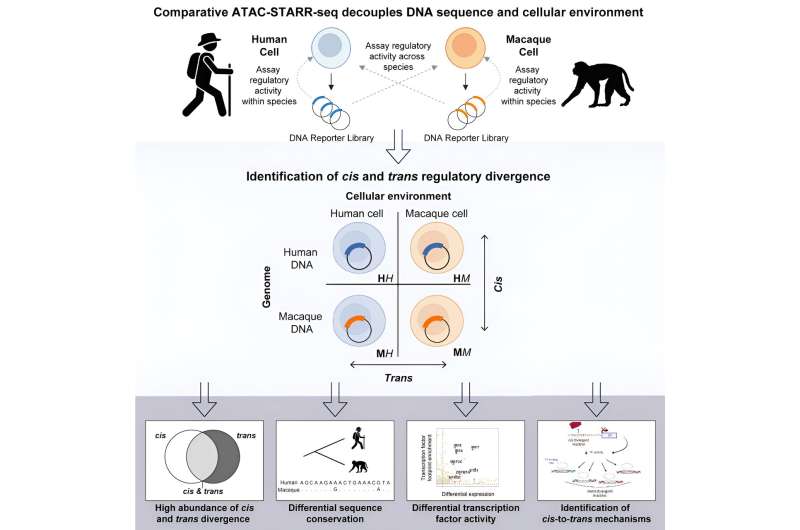This article has been reviewed according to Science X's editorial process and policies. Editors have highlighted the following attributes while ensuring the content's credibility:
fact-checked
peer-reviewed publication
trusted source
proofread
Researchers report on mechanisms of gene regulatory divergence between species

Closely related animal species can look physically different, but you might be surprised to learn that those differences can result not only from DNA sequence changes that alter proteins' structure or function, but also because changes in the DNA affect how those proteins are expressed. To add to that, not all differences between species can be explained by DNA sequence changes alone.
Molecular biologist Emily Hodges, assistant professor of biochemistry, studies the regulatory elements of our genome and is interested in parsing how changes in DNA sequence affect gene regulation.
The expression of genes is controlled by DNA sequence regulatory elements such as gene enhancers, which help increase the expression of a target gene.
Species-specific changes in enhancer function can result from DNA sequence changes that occur directly within a single enhancer (cis) or within the cellular environment in a way that can affect thousands of enhancers (trans). For instance, a transcription factor—a mobile protein that drives expression of a target gene—is a trans regulatory element that can bind and control enhancers on different chromosomes.
Historically, scientists have had trouble determining the individual contributions of these two mechanisms to gene expression divergence.
The labs of Hodges and former colleague Tony Capra, who is now an associate professor of epidemiology and biostatistics at the University of California, San Francisco, used ATAC-STARR-seq—a genome-scale reporter technique developed by the Hodges lab—to disentangle the relative contributions of cis and trans regulatory mechanisms to gene regulatory divergence between the closely related humans and rhesus macaques. The paper, "Human gene regulatory evolution is driven by the divergence of regulatory element function in both cis and trans," was published in Cell Genomics in April 2024.
With ATAC-STARR-seq, the researchers—led by recent Hodges lab graduate Tyler Hansen and recent Capra lab graduate Sarah Fong—looked at the effects of different DNA sequences (cis changes) within the context of different cellular environments (trans changes) and vice versa and found a substantially higher number of trans changes to gene regulatory activity than previously observed.
Differences between species are often attributed to sequence (cis) variation, but the Hodges and Capra labs uncovered a substantial role for cell environment (trans) differences in driving gene regulatory divergence between species. This work challenges current thinking that cis regulatory changes underlie most divergence in regulatory activity and argues a critical role for trans regulatory changes in driving gene regulatory evolution.
Parsing the relative contributions of cis and trans mechanisms of gene regulatory divergence has implications for the fields of gene regulation, human population genetics, and primate evolution.
Moving forward, Hodges is looking to extend the findings beyond human evolution to understand how cis and trans mechanisms of gene regulation contribute to differences in human disease risk. These questions are critical for understanding diseases like cancer where the interplay between sequence changes, epigenetics, and cellular environment strongly impacts disease outcomes.
A preview article discussing this research was published in the same issue of Cell Genomics.
More information: Tyler J. Hansen et al, Human gene regulatory evolution is driven by the divergence of regulatory element function in both cis and trans, Cell Genomics (2024). DOI: 10.1016/j.xgen.2024.100536
Megan Y. Dennis, Transforming our understanding of species-specific gene regulation, Cell Genomics (2024). DOI: 10.1016/j.xgen.2024.100540
Journal information: Cell Genomics
Provided by Vanderbilt University



















